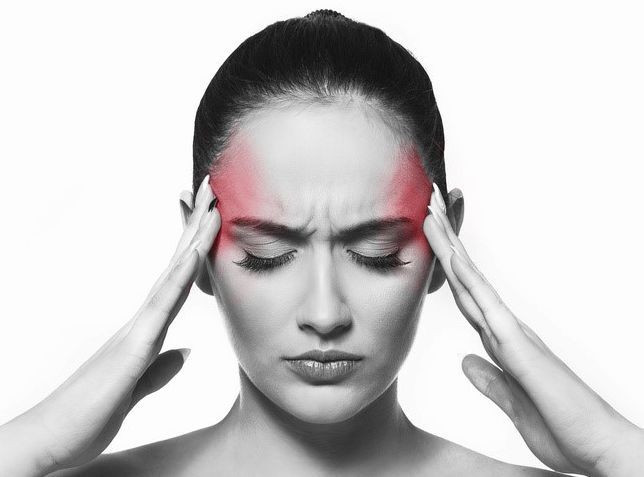
Migraine, known in Ayurveda as Ardhavabhedaka (meaning “breaking pain in half the head”) or sometimes correlated with Sooryavarta (pain that increases with the sun’s intensity), is considered a complex neurovascular disorder. It is primarily understood as an imbalance of Vata and Pitta Doshas.
- Vata Dosha (air and ether) is responsible for movement and nerve impulses. Its aggravation leads to pain, throbbing, dryness, and can cause restlessness and anxiety associated with migraine.
- Pitta Dosha (fire and water) governs metabolism, heat, and inflammation. Its aggravation leads to burning sensation, photosensitivity, nausea, and the intense, fiery nature of migraine pain.
- Ama (toxins) accumulation due to impaired digestion (Mandagni) is also a significant contributing factor, blocking channels and exacerbating dosha imbalances.
Ayurvedic treatment for migraine is holistic and personalized, focusing on:
- Balancing Vata and Pitta Doshas.
- Eliminating Ama and improving digestion.
- Nourishing the nervous system.
- Reducing inflammation and pain.
- Identifying and avoiding triggers.
- Promoting mental calm and stress reduction.
- Preventing recurrence.
Here’s a detailed overview of Ayurvedic treatment approaches for migraine:
I. Shodhana (Panchakarma – Detoxification and Purification Therapies): Panchakarma is crucial for chronic and severe migraines, as it addresses the root cause by deeply cleansing the body and pacifying aggravated doshas.
- Virechana (Therapeutic Purgation):
- Description: Medically induced purgation to eliminate vitiated Pitta and Ama from the gastrointestinal tract. Often preceded by Snehapana (internal oleation with medicated ghee like Triphala Ghrita, Brahmi Ghrita, or Panchatikta Ghrita).
- Benefits: Highly effective for Pitta-dominant migraines characterized by burning pain, photosensitivity, and nausea. It cleanses the liver and blood, reducing inflammation and heat.
- Nasya (Nasal Administration of Medicated Substances):
- Description: Instillation of warm medicated oils (like Anu Taila, Shadbindu Taila, Ksheerabala Taila, or Brahmi Taila) or herbal decoctions into the nostrils.
- Benefits: Considered paramount for head-related disorders. It helps to cleanse and nourish the nasal passages, clear blocked channels in the head, soothe the nervous system, reduce Vata and Pitta, and alleviate pain and pressure.
- Shirodhara:
- Description: A continuous, gentle stream of warm medicated oil (like Brahmi Taila, Ksheerabala Taila), medicated buttermilk (Takra Dhara), or milk (Ksheera Dhara) is poured over the forehead (“third eye” area).
- Benefits: Profoundly calming for the mind and nervous system. It directly pacifies Vata and Pitta, reduces stress, anxiety, mental fatigue, and the intensity and frequency of migraine attacks.
- Shirobasti / Shiropichu:
- Description: Shirobasti involves creating a dam on the head and filling it with warm medicated oil. Shiropichu involves placing a cotton pad soaked in warm medicated oil on the crown of the head.
- Benefits: Deeply nourishes the brain and nerve tissues, effectively pacifies Vata, reduces dryness and hyperactivity in the head, and promotes profound relaxation.
- Abhyanga (Herbal Oil Massage):
- Description: Full-body massage with warm, Vata-Pitta pacifying oils. Focus on head, neck, and shoulders.
- Benefits: Calms the nervous system, improves circulation, releases muscle tension (often associated with migraine triggers), and grounds Vata.
II. Shamana (Palliative Therapies & Herbal Medicines): These involve internal medications to manage symptoms, balance doshas, and strengthen the body.
- Herbs for Pain Relief, Anti-inflammatory, and Nervine Tonics:
- Brahmi (Bacopa monnieri): Excellent nervine tonic, calms the mind, reduces stress and anxiety, and improves cognitive function.
- Ashwagandha (Withania somnifera): Adaptogen, reduces stress, anxiety, and balances Vata.
- Jatamansi (Nardostachys jatamansi): Strong nervine sedative and anxiolytic, helps with Vata-Pitta imbalances.
- Ginger (Adraka): Anti-inflammatory, pain-relieving, helps with nausea and indigestion associated with migraine. Can be taken as fresh juice, powder, or tea.
- Turmeric (Haridra): Potent anti-inflammatory and antioxidant. Often taken with warm milk.
- Coriander (Dhanyaka): Cooling properties, especially beneficial for Pitta-dominant migraines. Can be soaked overnight and consumed the water.
- Licorice (Yashtimadhu): Soothes irritated mucous membranes, anti-inflammatory, balances Pitta.
- Shatavari (Asparagus racemosus): Cooling, nourishing, and helps balance Pitta and Vata, especially beneficial for women’s hormonal migraines.
- Classical Formulations:
- Pathyadi Kwath/Kashayam: A common decoction for various headaches, effective for Pitta-Vata type migraines.
- Godanti Bhasma: A calcined preparation, particularly useful for headaches with burning sensation and fever.
- Kamadugha Rasa (Mouktika Yukta): Useful for Pitta-aggravated conditions, including burning sensations and excessive heat.
- Shiroshooladi Vajra Rasa: Specifically designed for various types of headaches.
- Mahashankha Vati: Aids digestion and reduces Ama, useful if digestive issues trigger migraines.
- Triphala: Gentle detoxifier, helps regulate bowel movements and eliminate Ama.